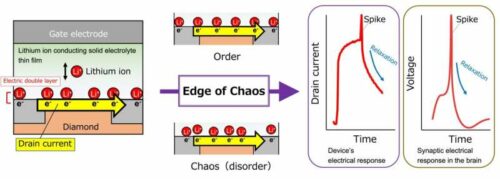Researchers have developed an energy efficient brain inspired AI device that offers high performance in data processing tasks.

One may wonder what the world’s best or fastest computer would look like? Philosophers may say – ‘mind’, biologists may say – ‘brain’. But engineers might differ, until now. Our brain can process a variety of data in parallel which we may not be aware of, for example, the constant pumping of our heart and the subconscious processing of data as well. The human brain is far more energy efficient than the computers used in current AI technologies and superior in information processing performance. One possible reason for this is that the “edge-of-chaos” state taking place in the brain has not been incorporated into computers.
Inspired by this ability of the human brain, researchers at the Tokyo University of Science have developed an AI device with high information processing performance. This was achieved by recreating the so-called “edge-of-chaos” state occurring in the brain using ion–electron-coupled dynamics at the solid electrolyte/diamond interface. The device operates similarly to an electric double layer transistor in that its electrical resistance changes with the changing charge/discharge states of the electric double layer.
The device induces an edge-of-chaos state which enables it to produce electrical responses with spike and relaxation patterns similar to those of synaptic responses in the brain and efficiently process information. As a result, this AI device was able to convert waveform input signals into signals in a different, intended waveform six times more accurately than other similar small AI devices, achieving the world’s highest performance at this task.
This technology may be used to develop energy-efficient edge AI devices with a wide range of applications, including pattern recognition in images (including facial recognition), voices and odors. The application may extend to energy-efficient edge AI devices that could be combined with various sensors to create smart watches, surveillance cameras, voice recognition systems and other technologies with a wide range of applications (e.g., medicine, disaster preparation, manufacturing and security).
Reference : Daiki Nishioka et al, Edge-of-chaos learning achieved by ion-electron–coupled dynamics in an ion-gating reservoir, Science Advances (2022). DOI: 10.1126/sciadv.ade1156










Sounds complicated
Test